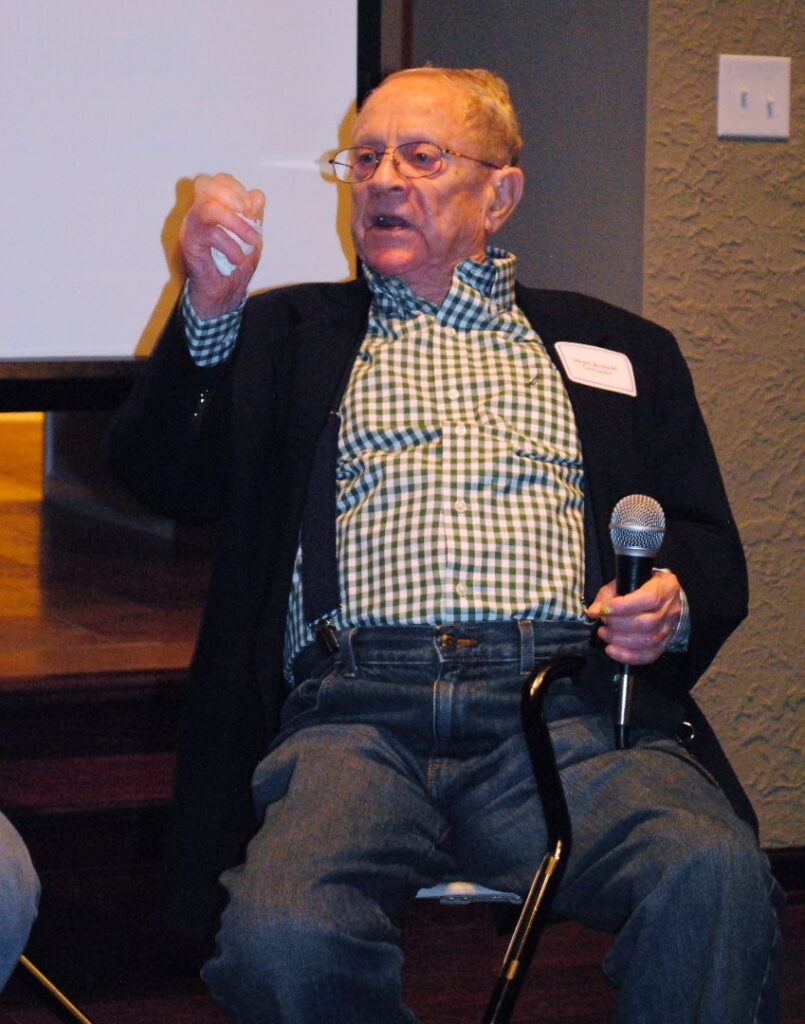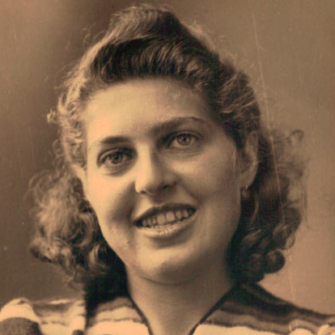Meyer Bronicki was born on March 20, 1924, in Dworzec, Poland. He lived in the village center with his parents, Feivel and Golda, and three brothers, Shabatai, Lippa, and Jack. Meyer’s father was a carpenter, and his mother was a seamstress and homemaker. Dworzec was a small village in northern Poland; half of the population, around 500 people, were Jewish. Meyer attended a parochial school, and after school, he attended cheder. Growing up, he enjoyed playing with his friends, fishing, and hiking in the nearby forests.
The Bronicki family had a good relationship with their non-Jewish neighbors, and Meyer had non-Jewish friends in the next village. However, some still harbored antisemitic sentiment, and children at school threw rocks at Meyer for being Jewish.
After finishing grade school, Meyer studied at a religious school in Baranowicze (current-day Belarus) until the beginning of the war. Meyer had heard rumors of war from his older brother, Lippa, who was serving in the Polish Army. These rumors were confirmed as German troops invaded Poland on September 1, 1939, and under the Molotov-Ribbentrop Pact, Germany and the Soviet Union divided Poland. A few weeks later, Russian tanks thundered into Dworzec. During Soviet occupation, stores were closed, and the population of Dworzec was forced to work for the Soviet government. Meyer, a young teen at the time, attended a Russian school.
One day in the summer of 1941, Meyer looked outside and counted forty German planes diving through the sky. They came down over the Soviet military airport and machine-gunned the workers. Germany had broken the Molotov-Ribbentrop Pact and launched Operation Barbarossa in June 1941—the invasion of the Soviet Union. The Russian soldiers in Dworzec began retreating, leaving behind artillery and tanks as they fled east. Lippa left with them. The remainder of the Bronicki family stayed in Dworzec, not imagining the horror to come under Nazi occupation.
The German authorities announced that all Jews were required to wear yellow stars, and a Judenrat was established. The Jews of Dworzec underwent forced labor. Meyer cut wood for the construction of a German hospital and was forced to guard machinery left by the Russians.
In the fall of 1941, Jews from nearby towns were brought to Dworzec, and a labor camp was established. Meyer was in a forced labor brigade that collected barbed wire and cut wood for boundary fences. The camp was soon enclosed, and those caught outside the boundaries were shot. The camp was overcrowded, with three families in a room. There was little food and poor sanitary conditions. Still, Meyer hoped that he and his family would survive. “Without hope, you couldn’t survive,” he said. Meyer’s main job in the labor camp was working in a quarry.
In the summer of 1942, Meyer heard that Jewish populations were being liquidated in other villages. Meyer knew that the liquidation of Dworzec was just a matter of time. He created a hiding place in the room he shared with his mother and brothers. He dug a hole beneath his bed, carrying dirt away in his pockets to discreetly dispose of it over time. One morning, Meyer looked out the window and saw what he had feared—the Germans were surrounding the labor camp.
The Germans ordered everyone to the main gate with the lie that they were being “resettled.” Meyer’s father had already been taken away to “prepare” the new location of the labor camp. Meyer never saw him again. He was murdered at Majdanek Concentration Camp.
Meyer knew what he needed to do. He broke the windows, tore pillows, and knocked over furniture to make it appear that the room had already been searched. Meyer, his mother, and brothers hid in the prepared hiding place, sliding plywood over the covering, and waited.
The sound of jackboots filled the building the following morning. Nazi soldiers searched for those in hiding. Meyer heard when they discovered a group of Jews in the basement and the gunshots that followed. Suddenly, the door opened to the Bronicki’s room. Through a crack in the floor, Meyer could see Nazi boots. His heart was pounding. This was the minute between life and death. Finally, the soldiers left, and relief was palpable.
The Nazis set fire to the village, and Meyer and his mother fled into the nearby forest a mile away. They were forced to leave Meyer’s oldest brother, who had polio and couldn’t walk, behind. They left him in the care of nearby Gentile friends. Meyer hoped to return for him, but that proved to be impossible. Later, Meyer heard from a villager that the Nazis had shot his brother. Meyer’s younger brother Jack was with his forced labor brigade when the camp was surrounded. He managed to escape into the forest. It would be six months until Meyer saw him again as a fellow partisan.
Under the cover of darkness, Meyer and his mother entered a neighboring village and wandered from friend to friend, trying to find a hiding place. One man gave them a shovel and pick to build a bunker in the forest, and a woman gave them bread.
Meyer dug a bunker in a patch of woods behind the village underneath a low-hanging spruce tree. It was deep enough to sit in, and he covered the hideout with branches and dirt, using straw as insulation. It was winter, and Meyer traveled to the village for bread during snow storms to cover his footprints. His shoes and socks would freeze to his feet after trekking through the snow. They survived in the bunker for three months, with temperatures outside dipping to -35 degrees at times.
Meyer and his mother were connected with the Bielski Brigade, an all-Jewish partisan group, through his mother’s friend in the village. She arranged a meeting, and the partisans took Meyer and his mother into the Naliboki Forest, where the Bielski partisans had built a camp to protect themselves and Jewish non-combatants. Meyer was later reunited with his younger brother in the forest, who had joined the Bielski partisans in 1943.
As a partisan, Meyer was trained for guard duty and became an expert in building bunkers without using nails. In the summer of 1943, the Germans launched a manhunt to locate partisans in the Naliboki Forest. At this time, the Bielski Brigade had grown to approximately 700 people and obtained aid from local villagers. To evade discovery, the Bielski Brigade moved to a new location in a swampy area along the Niemen River.
Meyer was nearly killed many times. Once, he was carrying a bucket of water, and a bullet from a Nazi soldier went through the bucket, missing him by inches. Another time, he was under siege by several Nazi soldiers and recalled looking up to see a rain of pine needles sprinkling down on him as the bullets pierced through the forest vegetation.[1] “God took me by the hand and led me around all the time,” Meyer said.
In June 1944, the Bielski Brigade, which had increased to over 1,200 people, met the advancing Russian Army as they liberated the east. Meyer, his mother, Lippa, and Jack returned home to Dworzec before moving into a displaced persons camp in Landsberg. In 1951, the Jewish Federation of Indianapolis sponsored Meyer, his mother, and his brothers, and they immigrated to Indianapolis.
Meyer worked for the Pennsylvania Railroad from 1952-1967. He visited Israel in 1958, meeting his future wife, Shoshana. They married that year, and in 1959, Shoshana immigrated to Indianapolis. In 1969, Meyer became a licensed electrician and started Meyer Electric Service.
Meyer and Shoshana had two sons, Phillip and Ronald, and built a happy and fulfilling life. Meyer was actively involved with the local Jewish community. He was a member of Congregation Beth-El Zedeck and the Jewish Community Center Association. Meyer openly shared about his Holocaust experiences. His favorite audience was young adults, likely because he was one himself during the war.
Meyer visited his hometown of Dvoretz but never returned to the forest where he was a partisan. He remained a faithful believer in God and passed away on April 28, 2016. He has four grandchildren.







